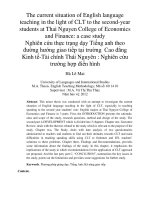ENGLISH LANGUAGE TEACHING METHODOLOGY HUBT
Bạn đang xem bản rút gọn của tài liệu. Xem và tải ngay bản đầy đủ của tài liệu tại đây (68.65 KB, 8 trang )
HANOI UNIVERSITY OF BUSINESS AND TECHNOLOGY
FACULTY OF ENGLISH LANGUAGE STUDIES
ENGLISH LANGUAGE TEACHING METHODOLOGY
ASSIGNMENT
WHAT ROLE DO YOU THINK MOTIVATION PLAYS IN
LEARNING A LANGUAGE? HOW CAN LEARNER
MOTIVATION BE DEVELOPED?
Student’s name: Thái Thị Vân Anh
Class: TA24.15
Student code:19125024
Hanoi, 2022
1
2
Contents
I.
Motivation Background............................................................................................................3
II. Roles of Motivation..................................................................................................................3
III.
Factors Effect Motivation in Learning Second Language....................................................4
IV.
Strategies to Develop Learners’ Motivation.........................................................................5
V. Conclusion................................................................................................................................6
References........................................................................................................................................7
3
I. Motivation Background.
The achievement or failure of facing obstacles can be seen as a crucial explanation
of motivation. According to Alizadeh (2016), learners who have the right motivation can
success in learning a second language. The success of individuals in overcoming any
difficulties relates to determination and the range of attempts to achieve their objectives.
The Gilakjani, Leong, and Sabouri researchers defined this fact as a psychological
component, which is mentioned as motivation. In the study of Nguyen (2019), he claimed
that motivation consists of effect, effort, and desire. The effect component refers to the
emotional responses of students to learning a new language, while the effort element
considers the studying time of the learners and the enthusiasm for learning a second
language (L2). Moreover, the desire factor is seen as the extent of language learners who
want to be fluent and good at their language. Motivation term is as significant as learning
term which help L2 learners gain their achievement. This is because learning provides
knowledge and skills for learners, while motivation gives them the encouragement to
achieve their process of learning. In the article of Khansir and Dehkordi (2017), the study
mentioned that the learning of a foreign language can be impacted by a variety kinds of
motivation. Alizadeh (2016) and Dehkordi (2017) also claimed that lecturers, L2 learners,
investigators, and material developers confirmed that the motivation element helps
learners be proficient in L2.
II. Roles of Motivation.
The investigation of Alizadeh researcher divided motivation into 4 terms, which
were intrinsic, extrinsic, instrumental, and integrative motivation [ CITATION Ali16 \l
1033 ]. Intrinsic motivation is defined as the inspiration for participating in the activities
due to the satisfaction reason. In contrast, extrinsic motivation is the way that learners
join to gain potential targets, such as rewards or avoid punishment. Another motivation
component is instrumental motivation, which means the L2 learners use motivation to
4
learn the language for specific purposes such as future job opportunities, translation,
interpretation, understanding the technical materials, and so on. The last term of
motivation is integrative motivation which is seen as the integration of L2 students into
the social exchange and culture of their L2 learners' group. The continuation of
Alizadeh’s investigation shows that intrinsic motivation plays an important role for L2
students in learning reading and speaking skills as well as acquiring knowledge and
obtaining achievement. Another declaration of Alizadeh is that integrative learners gain
higher proficiency in learning language than those with instrumental motivation
[ CITATION Ali16 \l 1033 ]. Furthermore, the study of Nguyen (2019) claimed that L2
learners with motivation study efficiently and quickly rather than those with low levels of
motivation. One more function of motivation is that it helps learners become active and
increase attention when studying and doing tasks. Nevertheless, low motivated learners
have less attention, discipline problems, or even cause misbehavior.
Apart from this, Christianto and Karin (2019) researchers show that motivation's
roles are significant in both teaching and learning. According to Christianto's study, the
purpose of motivation is to determine learning, which helps learners find the solution to
solve their problem during study progress. As well as that, L2 learners can have positive
attitudes when the motivation provides them with advantages of L2 and specific purposes
of learning a foreign language. Additionally, Christianto and Karin (2019) mentioned that
the role of motivation in learning language is persistence because the students will pay
attention to learning for certain purposes and keep perseverance to achieve their goals.
III. Factors Effect Motivation in Learning Second Language.
In the study of Nguyen (2019) researcher, there are several factors that impact
students' motivation for L2. First and foremost, the physical condition of the classroom
environment is important to raising students' motivation. For instance, blurry lighting,
small size board, and a stuffy classroom have the physical impact of decreasing students'
5
motivation. Subsequently, teaching approach is the way that lecturers teach students,
which means that when teachers have a good teaching method, the students will have
motivation to study and vice versa. Moreover, learning achievement is an element that
effects learners because the level of activities in any lecture will impact the motivation of
learning in students. To clarify, when the lecturers provides advanced activities that may
cause students' depressed. But if the activities are too easy, the students will lose their
motivation.
IV. Strategies to Develop Learners’ Motivation.
Along with some negative impact of L2 learners’ motivation, there are some
recommendations for foreign teaching methodologies that help lecturers increase student
motivation in learning language. The fist method is to raise the passion of studying in
each learner [ CITATION Gil12 \l 1033 ]. Passion is the core method to develop learners'
motivation in learning foreign language. The passion of learners relates to their goals'
life, consideration things and emotional things of them. For this method, the L2 learners
need to detect and connect between their passion and learning foreign language. In
addition, lecturers also provide variety method to help students find passion connects
with learning and keep their motivation. There are some activities that teachers can use in
class such as create culture for the class, design games, discover students’ personalities,
individual tasks, speaking circle, and so on.
The next way to motivate learners is to change thé reality of the learners. In this
method, Gilakjani, Leong, and Sabouri recommended teachers support students with a
high quality of instruction in which the learners can interact, get opportunities to learn
new things, and create connections with their learning motivation. Lecturers'
responsibility is to keep learners' motivation for participating in outside activities.
Lecturers can guide them to good learning websites, use a diversity of learning sources,
6
and use different kinds of teaching methods. These efforts from teachers will help
students change their reality perceptions to be interested in learning language.
The connection between learning and activities is also a good method to develop
students' motivation[ CITATION Gil12 \l 1033 ]. In-class activities help L2 learners build
their brains and improve their memory. Lecturers also need to give feedback to learners
after activities to help them learn more effectively and improve themselves.
V. Conclusion.
In the final analysis, motivation in learning the second language is important to
students and lecturers so motivation needs to be considered as a core of encouraging
students to learn the language. Through many investigations of some researchers, the
motivation of learners can increase or decrease based on the surrounding environment
and the interaction of learners and teachers. Motivation plays a crucial role for students
who are learning a foreign language. The persistence of motivation in L2 learners also
needs the support and guidelines from their teachers for them to find the connection
between learning and motivation.
7
References
Alizadeh, M. (2016). The Impact of Motivation on English Language Learning. nternational Journal of
Research in English Education.
Christianto, D., & Karin, I. (2019). The roles of motivation in the English language learning. The Journal of
Educational Development, DOI: 10.15294/JED.V7I1.29627.
Gilakjani, A. P., Leong, L.-M., & Sabouri, N. B. (2012). A Study on the Role of Motivation in Foreign
Language Learning and Teaching. I.J. Modern Education and Computer Science, DOI:
10.5815/ijmecs.2012.07.02.
Juniar , R. (2016). The Role of Motivation in Learning English for Indonesian Students. International
Journal of Management and Applied Science.
Khansir, A. A., & Dehkordi, F. G. (2017). The Role of Motivation in Teaching and Learning English
Language. Modern Journal of Language Teaching Methods.
Nguyen, C. H. (2019). Motivation in Learning English Language: a Case Study at Vietnam National
University, Hanoi. European Journal of Educational Sciences, DOI: 10.19044/ejes.v6no1a4.
8









